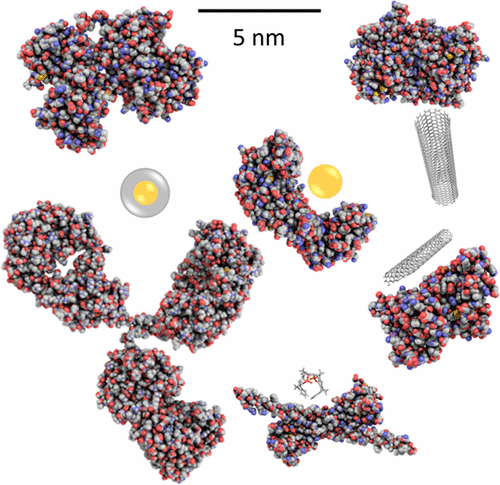当前位置:
X-MOL 学术
›
Acc. Chem. Res.
›
论文详情
Our official English website, www.x-mol.net, welcomes your feedback! (Note: you will need to create a separate account there.)
Nanoparticle–Protein Interactions: Therapeutic Approaches and Supramolecular Chemistry
Accounts of Chemical Research ( IF 18.3 ) Pub Date : 2017-05-08 00:00:00 , DOI: 10.1021/acs.accounts.7b00051 Mathis Kopp 1 , Sebastian Kollenda 1 , Matthias Epple 1
Accounts of Chemical Research ( IF 18.3 ) Pub Date : 2017-05-08 00:00:00 , DOI: 10.1021/acs.accounts.7b00051 Mathis Kopp 1 , Sebastian Kollenda 1 , Matthias Epple 1
Affiliation

|
Research on nanoparticles has evolved into a major topic in chemistry. Concerning biomedical research, nanoparticles have decisively entered the field, creating the area of nanomedicine where nanoparticles are used for drug delivery, imaging, and tumor targeting. Besides these functions, scientists have addressed the specific ways in which nanoparticles interact with biomolecules, with proteins being the most prominent example. Depending on their size, shape, charge, and surface functionality, specifically designed nanoparticles can interact with proteins in a defined way. Proteins have typical dimensions of 5–20 nm. Ultrasmall nanoparticles (size about 1–2 nm) can address specific epitopes on the surface of a protein, for example, an active center of an enzyme. Medium-sized nanoparticles (size about 5 nm) can interact with proteins on a 1:1 basis. Large nanoparticles (above 20 nm) are big in comparison to many proteins and therefore are at the borderline to a two-dimensional surface onto which a protein will adsorb. This can still lead to irreversible structural changes in a protein and a subsequent loss of function.
中文翻译:

纳米级蛋白质相互作用:治疗方法和超分子化学
对纳米颗粒的研究已发展成为化学领域的一个主要课题。关于生物医学研究,纳米颗粒已决定性地进入该领域,创造了纳米医学领域,其中纳米颗粒用于药物递送,成像和肿瘤靶向。除了这些功能外,科学家还研究了纳米粒子与生物分子相互作用的具体方式,其中最突出的例子是蛋白质。根据它们的大小,形状,电荷和表面功能,专门设计的纳米颗粒可以以定义的方式与蛋白质相互作用。蛋白质的典型尺寸为5–20 nm。超小纳米粒子(大小约为1-2 nm)可以处理蛋白质表面上的特定表位,例如酶的活性中心。中型纳米粒子(大小约为5 nm)可以与蛋白质以1:1的方式相互作用。与许多蛋白质相比,较大的纳米粒子(大于20 nm)较大,因此处于蛋白质将吸附到的二维表面的边界。这仍然会导致蛋白质中不可逆转的结构变化和随后的功能丧失。
更新日期:2017-05-08
中文翻译:

纳米级蛋白质相互作用:治疗方法和超分子化学
对纳米颗粒的研究已发展成为化学领域的一个主要课题。关于生物医学研究,纳米颗粒已决定性地进入该领域,创造了纳米医学领域,其中纳米颗粒用于药物递送,成像和肿瘤靶向。除了这些功能外,科学家还研究了纳米粒子与生物分子相互作用的具体方式,其中最突出的例子是蛋白质。根据它们的大小,形状,电荷和表面功能,专门设计的纳米颗粒可以以定义的方式与蛋白质相互作用。蛋白质的典型尺寸为5–20 nm。超小纳米粒子(大小约为1-2 nm)可以处理蛋白质表面上的特定表位,例如酶的活性中心。中型纳米粒子(大小约为5 nm)可以与蛋白质以1:1的方式相互作用。与许多蛋白质相比,较大的纳米粒子(大于20 nm)较大,因此处于蛋白质将吸附到的二维表面的边界。这仍然会导致蛋白质中不可逆转的结构变化和随后的功能丧失。


























 京公网安备 11010802027423号
京公网安备 11010802027423号